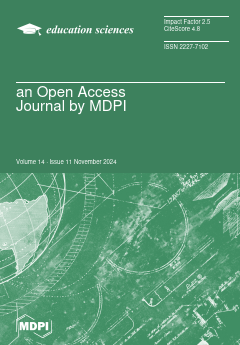This study analyses the higher education admission results of Hungarian ethnic minority students in Hungary originating from Central and Eastern European countries (Serbia, Croatia, Slovenia, Slovakia, Ukraine, and Romania) by secondary education background (national system vs. foreign system) and school-leaving qualification background (advanced
[...] Read more.
This study analyses the higher education admission results of Hungarian ethnic minority students in Hungary originating from Central and Eastern European countries (Serbia, Croatia, Slovenia, Slovakia, Ukraine, and Romania) by secondary education background (national system vs. foreign system) and school-leaving qualification background (advanced and intermediate levels in Hungary and their native country). Students (
n = 759) take (or have taken) part in undivided (5-year) and bachelor (3-year) programs at universities in Hungary and, for historical reasons, live as ethnic minorities in their home countries in the Carpathian Basin. There are significant differences in the number of students according to their secondary education background. Of the admitted students, 83.7% graduated from a national system secondary school and 16.3% from a foreign system secondary school before entering higher education. Using a Mann–Whitney U-test, we confirmed that the admission scores of students from the national secondary education system are significantly different from the scores of students who graduated from a foreign secondary education system (
p < 0.001). The results of the Jonckheere–Terpstra test demonstrated that students with advanced-level exam results performed significantly better than those who entered higher education with intermediate-level or native country examination results (
p < 0.001). However, there is no detectable difference (
p > 0.05) between students who graduate at the intermediate level and students who graduate with a native country certificate. A regression model, based on the median admission scores, exhibited a trend of improving results for foreign students. The R
2 quadratic determination coefficient is 0.705. This study provides insights into the educational pathways and decisions of Hungarian students residing abroad, underlining the influence of the national context and public education systems on their educational trajectories.
Full article





